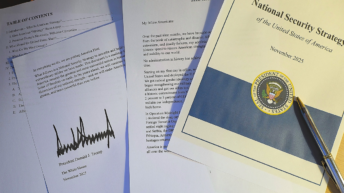
Introduction
On 17th July 2025, during the first official visit of Friedrich Merz as Chancellor, the United Kingdom and Germany signed a historic bilateral treaty at Kensington Palace. This treaty is being signed at a time when the security environment in Europe is marked by heightened instability- the ongoing Russia-Ukraine war, cybersecurity and hybrid threats, migration and border tensions, energy security as well as internal security threats (radicalisation, terrorism).
It is interesting to note that this treaty is the first of itst kind since NATO was founded.. For the first time in around 80 years, both the countries have committed to a clause on “mutual assistance” in case of attack and on “joint export campaigns” for manufacturing military equipment like fighter jets.
As the deal follows French President Emmanuel Macron’s visit to the UK, a few pertinent questions arise- Does this bilateral treaty reshape the European defence landscape especially in the context of the emerging (UK, France, Germany) framework? Furthermore, what are the key strategic components of the treaty and how do they reflect the current security environment of Europe?
Overview of the Treaty
Apart from the security aspect, the treaty covers the following domains of cooperation- migration, industry, multilateral alignments and people to people connect. To start with the most important component of the treaty- defence. The mutual assistance clause of the treaty commits both the countries to help each other in case of an aggression. Though this clause is similar to the article 5 of NATO, it is not merely symbolic but rather indicative of strategic priorities in Europe. Article 5 of NATO has traditionally been a foundational cornerstone when it comes to European security structure. Nonetheless, with the US President Donald Trump’s criticism of NATO and identifying it as a ‘bad deal’ for Washington, European leaders have certainly started evaluating NATO’s long term dependability. Additionally, earlier in 2025, President Trump stated that the US might not defend those allies who ‘don’t pay their fair share’. Hence, this bilateral move highlights growing pragmatism in the European security psyche. These parallel security arrangements through bilateral or potential trilateral frameworks appear to be an attempt of European leaders to operate with or without full engagement of the US.
Second most important crucial aspect of this deal is joint development of defence strike weapons. This includes 2000 km ranged missiles, drones, cyber defence mechanisms and also including German P-8 maritime patrol aircraft, operational from the UK bases for surveillance. In addition, the treaty includes protection of critical undersea infrastructure in the North Sea.
As on the economic front, the deal initiates significant industrial collaborations. For instance, German Rheinmetall is set to open a facility in the UK for manufacturing artillery gun barrels with British steel from Sheffield Forgemasters. According to Euro News report, this factory will also mark the first time that the UK has manufactured artillery gun barrels in 10 years.
On the internal security front, the treaty addresses illegal migration, specifically through the English Channel. The same was discussed during the 3-day long visit of President Macron to the UK. Both the countries reiterated the need for joint legal frameworks for tackling human smuggling networks across borders. In this aspect, Germany has pledged reforms to criminalize such routes.
As for people to people connect, both countries have emphasized youth and student travel programs. This covers visa-free group travel and streamlined e-gate access for UK citizens entering Germany and other EU countries. Lastly, as for multilateral engagements, the treaty formalises biannual UK-Germany summits.
Criticism of the Kensington Treaty
Despite the optimism provided by the Kensington Treaty, several criticisms of its long-term impact and implementation have arisen. Critics have raised doubts over the capability of bonhomie to provide enhanced security for Europe. The mutual assistance security clause mentioned in the treaty lacks the automatic mechanisms and institutional safeguards to deliver joint actions during a time of crisis. Critics have argued that without pre-determined thresholds and decision-making structures, this clause will prove to be vague and redundant during the crisis. Industrial and technological partnerships mentioned in the treaty will face bureaucratic hurdles and production issues within both the nations. Defence production in Germany is already marred by several impediments. It includes prolonged parliamentary process and environmental clearances. For instance, defence production in Germany requires compliance with environmental laws and public consultation. Similarly, there have been several delays in delivery of equipment. For example, Germany delayed multiple times, due to logistical issues, the delivery of Marder infantry fighting vehicles and Leopard 2 tanks to Ukraine. Previously, there have been instances of delayed defence projects. To give an example, the Eurofighter Typhoon, co-produced by Germany, the UK, Italy, and Spain faced hurdles due to technical disagreements, cost overruns and slow export approvals. At the same time, even in the UK, restarting domestic artillery production is a significant undertaking and may face challenges because the Sheffield Forgemasters, since its nationalisation in 2021, is still not producing at full scale.
Impact on Europe
The Kensington treaty has been approved at a critical juncture when there are rising doubts about the US’s commitment to NATO and European security. The treaty will act as an example for other European nations within NATO, looking outside NATO for defence agreements that can safeguard their respective national security interests amidst changing global alliances and prevailing uncertainties.
If the treaty succeeds in providing visible outcomes in the near future, other European countries, including Italy, the Netherlands, Spain, and Nordic nations, are likely to follow suit. It will give a fresh momentum to mutual defence cooperation between these nations. It will also create a new mechanism that will supplement and simultaneously bypass existing EU and NATO structures, thereby reducing redundant bureaucratic hurdles and over-dependence on the US for security guarantees.
Conclusion
The treaty represents the changing European security architecture and industrial cooperation post-Brexit. By institutionalizing cooperation within the two largest European economies, the treaty aims to address perceived security challenges from Russia and the unpredictability of American support. It also sets the stage for a more self-reliant and self-assured Europe through mutual cooperation. However, implementation of the treaty will require political commitment and stability within both nations. It will be necessary to navigate inherent legal, and structural challenges to enhance and maintain the momentum generated by E3 consultations. The UK and Germany can provide a solid foundation for future European defence mechanisms and industrial cooperation more robust, resilient, flexible, and capable. The treaty stands as a symbol of European capability to adapt and maneuver the regional as well as global challenges.






Add comment